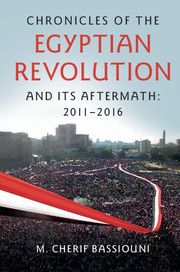Book contents
- Frontmatter
- Dedication
- Contents
- Preface
- Acknowledgments
- List of Abbreviations
- Introduction
- 1 The Early Stage of the Revolution
- 2 Mubarak Relinquishes the Presidency and the SCAF Assumes Power
- 3 A Prelude to Democracy: 2011–2012 Elections
- 4 The Morsi Presidency: June 30, 2012 to July 3, 2013
- 5 The Military's Return to Power and the El-Sisi Presidency
- 6 2015Legislative Elections and the Changing Civilian Political Landscape
- 7 The Military Institution: Its Power, Influence, and Culture
- 8 Violence and Repression
- 9 The Accountability Gap
- 10 The Justice System in Crisis
- 11 The Constitutional Quagmire
- 12 Demographics, Education, and the Economy
- 13 Geopolitical Factors
- 14 Concluding Assessment
- Pictures of the Egyptian Revolution and Related Events
- Bibliography
- Index
11 - The Constitutional Quagmire
Published online by Cambridge University Press: 24 November 2016
- Frontmatter
- Dedication
- Contents
- Preface
- Acknowledgments
- List of Abbreviations
- Introduction
- 1 The Early Stage of the Revolution
- 2 Mubarak Relinquishes the Presidency and the SCAF Assumes Power
- 3 A Prelude to Democracy: 2011–2012 Elections
- 4 The Morsi Presidency: June 30, 2012 to July 3, 2013
- 5 The Military's Return to Power and the El-Sisi Presidency
- 6 2015Legislative Elections and the Changing Civilian Political Landscape
- 7 The Military Institution: Its Power, Influence, and Culture
- 8 Violence and Repression
- 9 The Accountability Gap
- 10 The Justice System in Crisis
- 11 The Constitutional Quagmire
- 12 Demographics, Education, and the Economy
- 13 Geopolitical Factors
- 14 Concluding Assessment
- Pictures of the Egyptian Revolution and Related Events
- Bibliography
- Index
Summary
INTRODUCTION
The legal battlefield of constitutionalism is often where the struggle for power is fought. The rulers and the beneficiaries of their regimes seek to make constitutional texts as appealing as possible to the general public while preserving avenues to avoid accountability and transparency. In Egypt, constitutions are where proponents and opponents of democracy, the rule of law, and human rights confront each other.
Societies reflect their historical experiences in their constitutions, frequently borrowing from the experiences of other societies, which is why national constitutions reflect the migration of ideas. You can see this clearly in post–World War II constitutions, in which the language reflects international human rights norms once contained in treaties. Also, in many states, the justiciability of constitutional rights become subject to specialized constitutional courts as well as regional human rights courts, in the cases where the state has adhered to a regional convention on human rights containing such a mechanism.
Egypt's constitutional enactments go back to the 1800s, but progress toward democracy, the rule of law, and human rights has been slow. The history of Egyptian constitutionalism reveals a practice in which promulgated texts contain declaratory statements of rights but that are subject to limitations that can be used by those in power to negate those very rights for others.
The 1923 Constitution was a step toward democracy. Egypt's first bright light in the evolution of limiting the king's power and of transferring parts of these powers to an elected legislative body. This Constitution contains similarities to its 1923 predecessor, but it also contains what can be considered escape hatches whereby the ruler, in one way or another, could prevail over the will of the people. The 1971 Constitution did establish a Constitutional Court, which has somewhat advanced democracy, the rule of law, and human rights.
What is particularly interesting about the period from 2011 to 2014 is the processes through which constitutional declarations, amendments, and even new constitutions were drafted, promulgated, and submitted to public referenda. And what is especially surprising is to see how little concern people had for the legality of these processes.
- Type
- Chapter
- Information
- Publisher: Cambridge University PressPrint publication year: 2016

